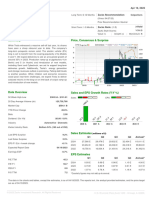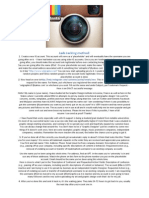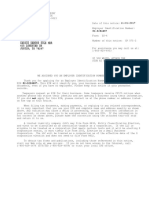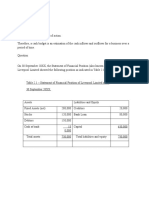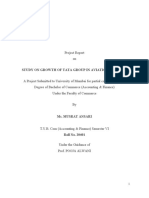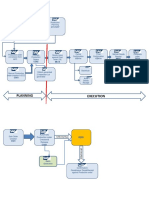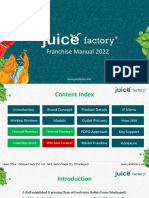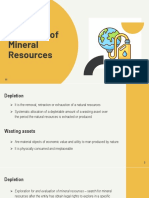### Net Income Analysis
**Question: What factors might have contributed to Tesla's net income of $5,000 million in
2023?**
**Analysis:**
Tesla's substantial net income of $5,000 million can be attributed to several factors:
- **Increased Sales:** Expanded vehicle deliveries globally, especially with the introduction of
new models like the Model Y and Cybertruck, likely boosted revenue.
- **Cost Control:** Efforts in managing operational expenses and production costs could have
improved profitability.
- **Production Efficiency:** Enhanced manufacturing processes and economies of scale might
have lowered per-unit production costs, thereby increasing margins.
### Depreciation and Amortization
**Question: Why is depreciation and amortization added back to the net income in the cash flow
statement?**
**Analysis:**
Depreciation and amortization are non-cash expenses that reduce net income but do not affect
cash flow. Adding them back to net income in the cash flow statement adjusts for these
expenses, providing a clearer picture of the cash generated from operating activities.
### Changes in Working Capital
**Question: How do the changes in accounts receivable, inventory, and accounts payable reflect
on Tesla's operational efficiency?**
**Analysis:**
- **Accounts Receivable Increase:** Indicates sales growth, but managing receivables efficiently
is crucial to converting sales into cash promptly.
- **Inventory Decrease:** Could signify effective inventory management or increased demand
outpacing production.
- **Accounts Payable Increase:** Potentially reflects improved supplier terms or increased
purchasing activities, providing short-term financing benefits.
### Capital Expenditures
**Question: Why did Tesla spend $4,500 million on property, plant, and equipment, and how
does this impact the company’s future growth?**
**Analysis:**
Tesla's significant capital expenditures support:
�- **Expansion:** Building new manufacturing facilities and charging infrastructure.
- **Innovation:** Developing new technologies for vehicles and energy products.
- **Capacity:** Increasing production capabilities to meet growing demand, ensuring future
revenue growth and market competitiveness.
### Marketable Securities Transactions
**Question: How do the purchases and sales of marketable securities affect Tesla's investing
cash flow?**
**Analysis:**
- **Purchases:** Reflect investments in short-term, liquid assets, potentially for strategic
purposes or to optimize returns on excess cash.
- **Sales:** Generate cash but might reduce future investment income or flexibility. Tesla’s
strategy likely balances liquidity needs with investment returns.
### Issuance and Repurchase of Common Stock
**Question: What are the reasons behind Tesla issuing and repurchasing its common stock in
2023?**
**Analysis:**
- **Issuance:** Raises capital for expansion, R&D, or debt repayment.
- **Repurchase:** Signals confidence in stock value or offsets dilution from employee stock
options. Both actions influence shareholder value and capital structure.
### Debt Transactions
**Question: How does the issuance and repayment of debt influence Tesla’s financial leverage
and cash flow?**
**Analysis:**
- **Issuance:** Increases debt capital for financing without diluting equity. Cost-effective if used
for growth.
- **Repayment:** Reduces interest expense but requires cash outflow. Balancing debt levels is
crucial for maintaining financial health and flexibility.
### Absence of Dividends
**Question: Why does Tesla not pay dividends, and how does this decision impact its cash flow
and investor perception?**
**Analysis:**
Tesla prioritizes reinvesting profits into growth:
�- **Cash Flow:** Retains more cash for operations, investments, and debt reduction.
- **Investor Perception:** Emphasizes long-term growth potential over immediate income,
appealing to growth-focused investors.
### Overall Cash Flow Analysis
**Question: What does the net increase in cash of $3,300 million indicate about Tesla’s financial
performance in 2023?**
**Analysis:**
A positive net cash increase signals strong operational performance and effective management
of investing and financing activities, bolstering liquidity and financial stability.
### Ending Cash Balance
**Question: How does the ending cash balance of $13,300 million position Tesla for future
opportunities and challenges?**
**Analysis:**
- **Strategic Flexibility:** Provides resources for R&D, expansion into new markets, and
strategic acquisitions.
- **Risk Mitigation:** Cushions against economic downturns or unexpected expenses,
enhancing resilience.
Through a comprehensive analysis of Tesla's cash flow statement, stakeholders can gain
insights into its financial health, strategic decisions, and potential future directions.

























